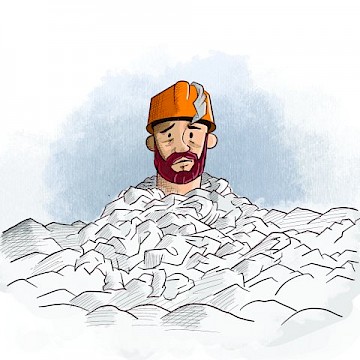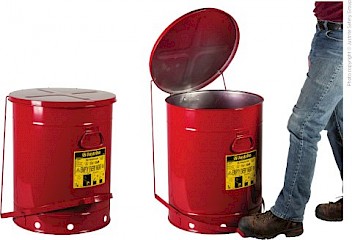What Do I Do with My Oily Rags?
 Rags are one of the most essential items to have for a lubrication technician, mechanic or anyone working on equipment on the plant floor. They’re a necessity for cleaning up greasy or oily surfaces on tools, machine components and our own hands once work is done. We can go through quite a few just working on one machine, especially during machine assembly and disassembly. When we drain the oil and dispose of any lubricants, there are procedures to follow to ensure we do not accidentally pose any safety, health or environmental risks with the waste oil. There are plenty of regulations established to help workers fully comprehend the importance of these procedures. But what about the materials, like rags, that are soaked with oil and grease? Do we just toss them out?
Rags are one of the most essential items to have for a lubrication technician, mechanic or anyone working on equipment on the plant floor. They’re a necessity for cleaning up greasy or oily surfaces on tools, machine components and our own hands once work is done. We can go through quite a few just working on one machine, especially during machine assembly and disassembly. When we drain the oil and dispose of any lubricants, there are procedures to follow to ensure we do not accidentally pose any safety, health or environmental risks with the waste oil. There are plenty of regulations established to help workers fully comprehend the importance of these procedures. But what about the materials, like rags, that are soaked with oil and grease? Do we just toss them out?
It’s common to find these rags or shop towels tossed into waste bins or left around. Aside from these, there are many other similar materials used for cleaning in industrial work environments, including lint-free cloths, spill mats, absorbent socks/dikes or loose absorbents. These are particularly necessary when spills occur but may be difficult to handle afterwards. The same holds true for other lubricant-contaminated materials - used oil filters, oil-soaked breathers and single-shot top-up containers can all contain leftover volumes of lubricant.
When oily rags and other lubricant-contaminated materials are handled properly, it keeps the workplace safe, clean and helps maintain an organized front. When this occurs, many other efficiencies can result. In addition to equipment operation, it also helps manage a stronger, healthier culture in the workforce.
A Brief History on Related Standards and Regulations
In 1973, under the Clean Water Act, the U.S. Environmental Protection Agency (EPA) implemented the Spill Prevention, Control, and Countermeasure (SPCC) regulation. This regulation aims to prevent oil pollution, and in turn, protect drinking water and natural resources. The SPCC regulation sets standards regarding the prevention of and response to oil discharges. The regulation requires that affected facility owners and operators prepare and implement spill prevention, control and countermeasure plan unique to their facility. Within these SPCC plans, standards are set for the containment and storage of oil-contaminated materials.
In 1976, Congress enacted the Resource Conservation and Recovery Act (RCRA). The RCRA created standards for identifying and handling hazardous waste and non-hazardous waste materials. A complete list of these standards can be accessed on the EPA’s official website, wherein you can find guidelines to determine if the materials that you are dealing with are considered hazardous or non-hazardous. This determination will dictate how you can dispose of your oil-contaminated materials.
EPA regulations require containers and above-ground tanks in which oil-contaminated materials are stored to be clearly labelled as “Used Oil.” Some State Environmental Protection Agencies may have additional standards; for example, California’s Code of Regulations requires that – in addition to being labelled as “Used Oil” – containers are labelled with the name and address of the oil source, the hazardous properties of the material being stored, the date that the container began accumulating used oil and the composition of the waste being contained (CCR, Title 22 § 66262).
It is not uncommon for individual companies to provide further regulations or specifications to be followed in combination with the legal regulations. As an example, the internal regulation guide for a particular chemical company dictates that “Oil contaminated material, such as filters, oil pads, etc., shall be disposed of [in] the dedicated environmental dumpsters at each oil storage area where the material can be recycled and disposed of properly by the environmental department.”
How to Store Oil-contaminated Materials
Drums and other industrial containers can be used to collect oil-contaminated materials. These containers should be appropriately labelled and easy to access. Many containers on the market have foot-operated and self-closing lids (Waste Disposal Safety Container. Proper storage containers make it easy to collect absorbents and reduce the risk of fires and oil contamination.
Knowing what containers to use is one thing, but it’s up to the plant to make these readily available where necessary and implement proper training for everyone to know how and when to use them. Having documented procedures also helps to ensure there is proper storage of oily rags and other similar materials. As part of the Ascend™ Methodology, one of the Energy Conservation, Health and the Environment factors focuses on the understanding of these disposal practices with Storage and Disposal of Used Oil And Materials (E2P). This should be a staple of safe workplaces.
Photo copyright © Justrite Safety Group
How to Properly Dispose of your Oil-contaminated Materials
 Once you have implemented proper storage procedures for your oily rags and similar materials, they cannot stay there forever. Next, a decision needs to be made on how to eventually dispose of these properly. Before choosing how to proceed, you will need to determine if your material is considered hazardous. This can be done by referencing the EPA guidelines mentioned previously. Additionally, you must determine if your material contains free liquid oil. Free liquids cannot be disposed of in the same ways as solid waste.
Once you have implemented proper storage procedures for your oily rags and similar materials, they cannot stay there forever. Next, a decision needs to be made on how to eventually dispose of these properly. Before choosing how to proceed, you will need to determine if your material is considered hazardous. This can be done by referencing the EPA guidelines mentioned previously. Additionally, you must determine if your material contains free liquid oil. Free liquids cannot be disposed of in the same ways as solid waste.
Materials can be tested to determine if they contain free liquids. One of the EPA-approved tests (Method 9095B) uses a conical paint filter (mesh number 60 +/- 5%). The test guidelines direct that “A predetermined amount of material is placed in a paint filter. If any portion of the material passes through and drops from the filter within the 5-min test period, the material is deemed to contain free liquids.” Exhaustive testing such as this is generally not needed; if your materials drip liquid when squeezed, they likely are considered to contain free liquids and cannot be disposed of with solid waste. This is particularly important to understand when considering the varying waste and disposal procedures between simply just an oily rag and the absorbent pads that may be soaked when handling a sizable oil spill.
Used oil filters can be drained of their contents and disposed of as non-hazardous waste. It is common for filters to first be placed on a grate that can allow dripped oil to collect into a drum. Additionally, oil crushers will push out most of the remaining oil into a used oil drum, while making the remainder filter more easily recyclable. According to the EPA (40 CFR Part 261), once oil filters are drained and crushed or dismantled, they are no longer considered hazardous waste (provided the filters are non-terne plated and are not mixed with hazardous waste materials). Beyond this, the EPA doesn’t regulate what happens to oil filters, although they encourage recycling.
Recycling programs exist for absorbents, and using these programs is more environmentally friendly than simply disposing of the waste. If used oil is to be recycled and used for energy recovery, the material will be collected and stripped of water and contaminants. The remaining oil is then burned; the heat produced can be used to power different industrial processes. Burning used oil for energy reduces the amount of new material that needs to be burned to create energy.
Additionally, your rags and shop towels may be eligible for industrial laundry services. These programs typically retrieve your absorbents, launder them offsite and then return them clean and ready to use again.
Did you know oily rags can start fires on their own?
As some oily rags sit, the oil in them can age and further oxidize. The oxidation process consumes oxygen and expels heat. Thus, if oily rags are thrown in the trash, placed in a pile or put in an inappropriate storage container, the heat produced by oxidation has nowhere to go. If the heat isn’t dispelled, the oxidized oil can reach temperatures hot enough to ignite the rag material, causing a fire without a spark also known as spontaneous combustion.
Conclusion
Properly storing and managing oil-contaminated materials, like rags and filters, not only creates an organized environment but also helps protect assets and your fellow workers. Properly labelling and using storage containers ensures that valuable materials are not cross-contaminated and improperly used. And of course, proper storage can help prevent fires and other accidents. So next time you decide to throw out an oily rag, think twice and do it right.
Author’s Note: Thanks to Hayden Beeson for his contribution to this article.
